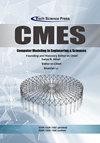Quick Weighing of Passing Vehicles Using the Transfer-Learning-Enhanced Convolutional Neural Network
IF 2.5
4区 工程技术
Q2 ENGINEERING, MULTIDISCIPLINARY
Cmes-computer Modeling in Engineering & Sciences
Pub Date : 2023-01-01
DOI:10.32604/cmes.2023.044709
引用次数: 0
Abstract
Transfer learning could reduce the time and resources required for the training of new models and be therefore important in generalized applications of the trained machine learning algorithms. In this study, a transfer learning-enhanced convolutional neural network (CNN) was proposed to identify the gross weight and the axle weight of moving vehicles on the bridge. The proposed transfer learning-enhanced CNN model was expected to weigh different bridges based on a small amount of training datasets and provide high identification accuracy. First of all, a CNN algorithm for bridge weigh-in-motion (B-WIM) technology was proposed to identify the axle weight and the gross weight of the typical two-axle, three-axle, and five-axle vehicles as they crossed the bridge with different loading routes and speeds. Then, the pre-trained CNN model was transferred by fine-tuning to weigh the moving vehicles on another bridge. Finally, the identification accuracy and the amount of training data required were compared between the two CNN models. Results showed that the pre-trained CNN model using transfer learning for B-WIM technology could be successfully used for the identification of the axle weight and the gross weight for moving vehicles on another bridge while reducing the training data by 63%. Moreover, the recognition accuracy of the pre-trained CNN model using transfer learning was comparable to that of the original model, showing its promising potentials in the actual applications.基于迁移学习增强卷积神经网络的过路车辆快速称重
本文章由计算机程序翻译,如有差异,请以英文原文为准。
求助全文
约1分钟内获得全文
求助全文
来源期刊

Cmes-computer Modeling in Engineering & Sciences
ENGINEERING, MULTIDISCIPLINARY-MATHEMATICS, INTERDISCIPLINARY APPLICATIONS
CiteScore
3.80
自引率
16.70%
发文量
298
审稿时长
7.8 months
期刊介绍:
This journal publishes original research papers of reasonable permanent value, in the areas of computational mechanics, computational physics, computational chemistry, and computational biology, pertinent to solids, fluids, gases, biomaterials, and other continua. Various length scales (quantum, nano, micro, meso, and macro), and various time scales ( picoseconds to hours) are of interest. Papers which deal with multi-physics problems, as well as those which deal with the interfaces of mechanics, chemistry, and biology, are particularly encouraged. New computational approaches, and more efficient algorithms, which eventually make near-real-time computations possible, are welcome. Original papers dealing with new methods such as meshless methods, and mesh-reduction methods are sought.
 求助内容:
求助内容: 应助结果提醒方式:
应助结果提醒方式:


